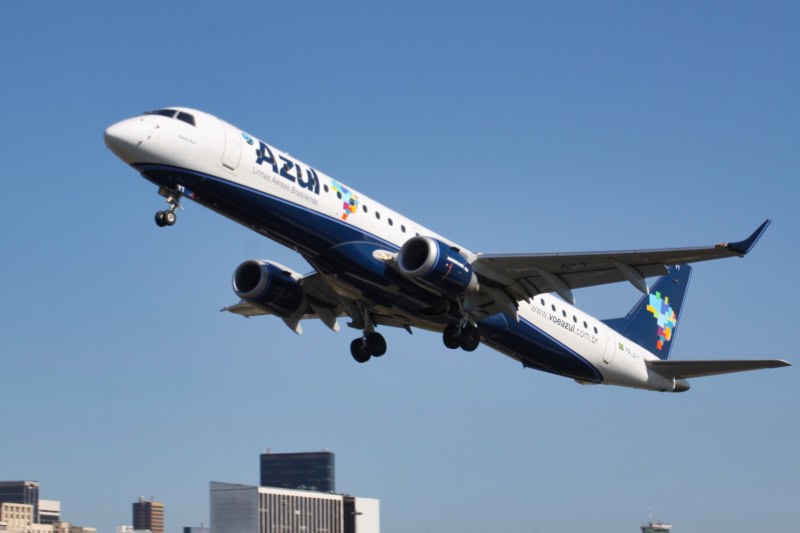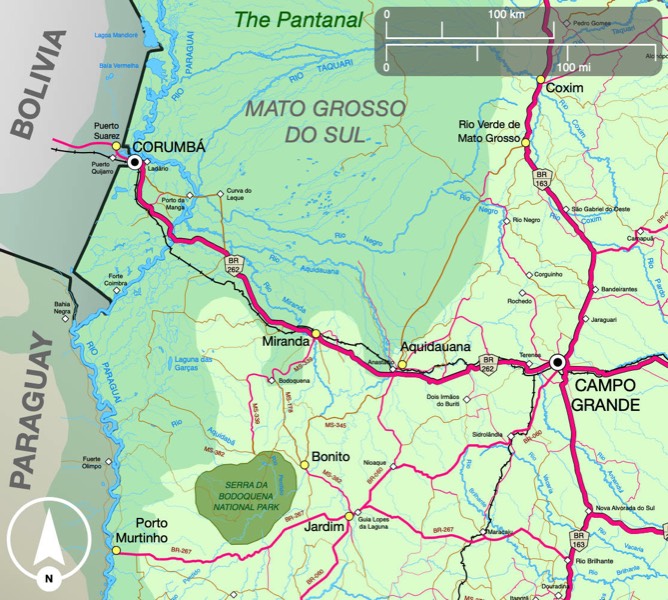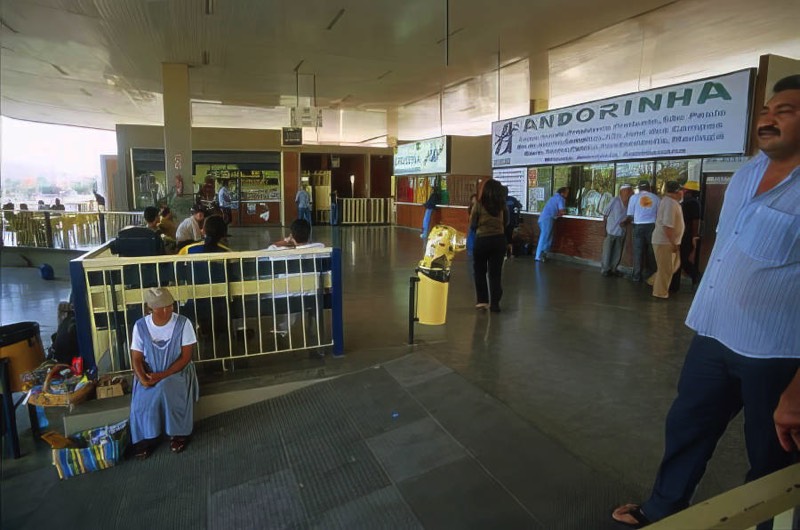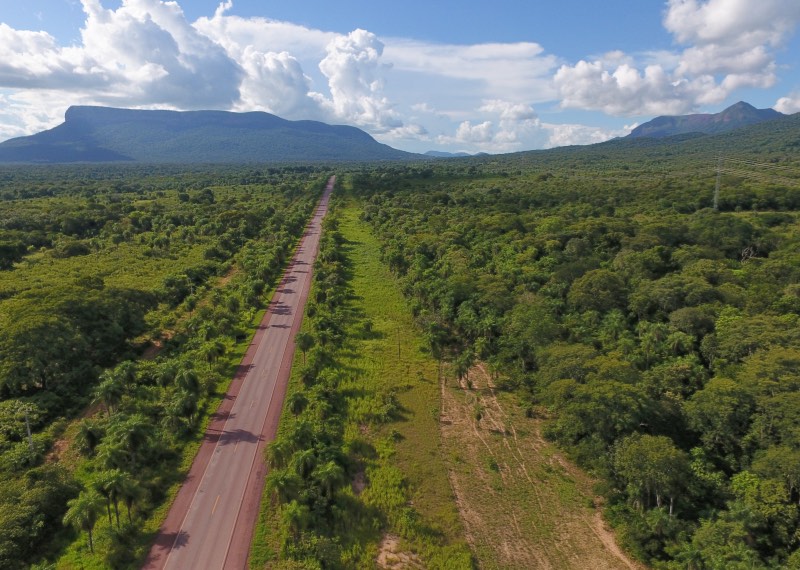Corumbá
Getting There and Away
By Air
Corumbá's main airport (code = CMG) is used primarily for small planes and aero-taxis serving the local cattle ranches. There also used to be regular flights onto other centers such as Campo Grande - but these have been scaled back so as to be almost non-existent. The exception is the three-times weekly flight offered by Brazil's Azul airlines going between Sao Paulo and Corumba. Note that Azul flies out of the Viracopos airport (VCP), which lies around 100km outside of metropolitan Sao Paulo - and is actually closer to the city of Campinas. This means that you may need to factor in that extra terrestial journey, e.g, via a shuttle, into your travel schedule.
Flights leave Sao Paulo after 8am and take around two hours ... noting that there's usually a short stop in Bonito. Once flight reaches Corumbá and offloads its passengers, it loads in new passengers for the return journey. The return journey takes longer, at around three hours. These flights currently take place on Tuesdays, Thursdays and Saturdays - but seem to change periodically.
When travelling between Corumba and Sao Paulo, you should also factor in the one hour time difference - noting that Brazilian states in the Pantanal region exist within the Amazonas Time (AMT) zone, whereas Sao Paulo is within the Brasília Time (BRT) zone. This simply means that Sao Paulo is one hour ahead. When you leave the Pantanal and reach Sao Paulo, remember to ensure your watch/phone is correctly set in the new time zone, otherwise this can result in a mad dash to catch subsequent flights.
Besides the airport in Corumbá, there's another airport across the Bolivian border in nearby Puerto Suarez. This formerly had weekly flights to/from Santa Cruz via the Bolivian airline Transporte Aereo Militar and (now defunct) AeroSur. However, the Bolivian services to Puerto Suarez have history of being intermittent - typically operating for a few months and then being discontinued. The last cancellation occurred several years ago, and its currently unknown if/when the service will be re-introduced.
Azul airlines offers flights between São Paulo (Viracopos airport) and Corumbá three times weekly: Tue, Thu and Saturdays. Note that São Paulo Viracopos airport is a regional airport located 100km near the town of Campinas in São Paulo state. The means that you'll need a shuttle service if travelling from São Paulo city or its airports. Photo Credit: Aeroprints.com
By Bus
This is often the best option if travelling between Corumbá and Campo Grande (and onto other Brazilian cities). There are services leaving every few hours. It's a seven hour bus ride, so investment in a more comfortable Executivo Class ticket (and an express bus without stops) is worthwhile.
If travelling to a fazenda or lodge on the Estrada Parque, you can take the non-express bus, and arrange with the bus company to have them drop you off at Buraco das Piranhas. This is located at the intersection of the Estrada Parque with BR-262. Some lodges will pick you up from here - but make sure to confirm with them beforehand, and ensure that they know when you'll be arriving, since there's nowhere to stay and nothing to do in Buraco das Piranhas if you're stuck.
By Road
The main road into Corumbá is 400km from Campo Grande, travelling along BR-262 via Miranda and Aquidauana. Although the road is paved, it is frequently pot-holed due to the heavy rains - so car is recommended. The journey typically takes 5-6 hours. There's also a road on Bolivian side for travel to Santa Cruz and other centres. However, these are often unpaved and should be driven with care.
By Train
Officially known as the Expreso Oriental, but better known as the Trem da Morte (Death Train), the overnight service runs between Puerto Quijarro (just over the border from Corumbá) and Santa Cruz. It runs three times weekly, and takes around 17 hours - but can take longer depending on the condition of the line. The landscapes are monotonous, so that the journey can't really be considered scenic. In fact, aside from it getting you to/from Santa Cruz, the main selling point is simply that you can tell your friends that you rode the Bolivian Death Train. However, if you use the service then its strongly recommended to travel Super Pullman class (or higher if available) as this ensures better security and the chance that you might actually get some rest. The train leaves from Puerto Quijarro at 4pm on Tuesdays, Thursdays and Sundays. The reverse journey from Santa Cruz runs on Mondays, Wednesdays and Fridays. Other services such as the Ferrobus and Trem Rapido run on other days but mightn't have the Super Pullman option.
There was formerly a tourist train known as the Trem do Pantanal which ran between Campo Grande and Miranda. Although it provided some great views of the Pantanal, the service was suspended in 2015 and didn't extend as far as Corumbá.
Transport within Corumbá
Taxis within Corumbá were always unreliable and expensive. Uber is now available as a better option - but check the driver reviews aand take care. Mototaxis (Motorcycle taxis) are a cheaper option if you're travelling without luggage ... but do so with caution. There are regular municipal buses leaving to the Bolivian frontier every 30 minutes during the day. These leave from Rua Dom Aquino, in front of the Praça da Independência.
Travel To/From Bolivia
Taxis are the easiest way of getting to the frontier, although there's also a municipal bus on the Brazilian side (refer to the Transport section above). Immigration between the two countries is an almost informal affair.
- Bolivia: The only immigration office is located on the frontier. This is where you'll need to stop for your Bolivian entry or exit stamp.
- Brazil: There's no immigration office on the Brazilian side of the frontier. Instead, you'll need to stop at the Federal Police office at the Praça da República. If you're leaving Brazil, remember to leave time (during office hours) to get your exit stamp before you leave. If the immigration offices are closed, you can cross the frontier without entry and exit stamps - just return when it's open and don't go beyond the towns on either side.
These stamps aren't needed if you're just making a quick trip over the frontier for shopping, money changing, or just organising your tickets for onward travel.
In the event you need a visa or renewal (requirements vary by the country which issued your passport) then check with the appropriate immigration office.
If the local bureaucracy demands that you have your visa issued outside the country then there's a Brazilian Consulate in Puerto Quijarro (Calle Santa Cruz) and a Bolivian Consulate in Corumbá (Rua Sete de Setembro, 47).
Select from the options below to learn more about Corumbá.











